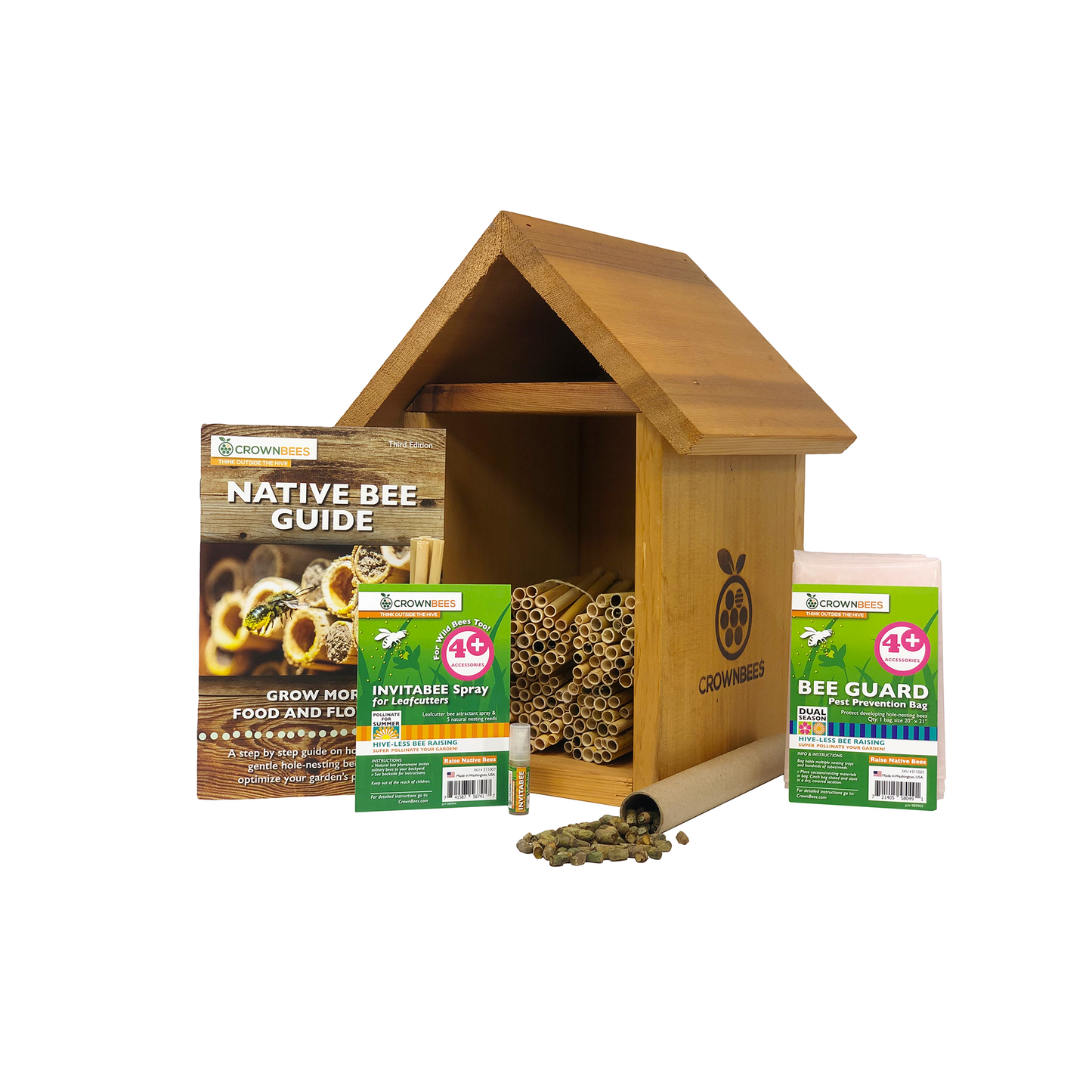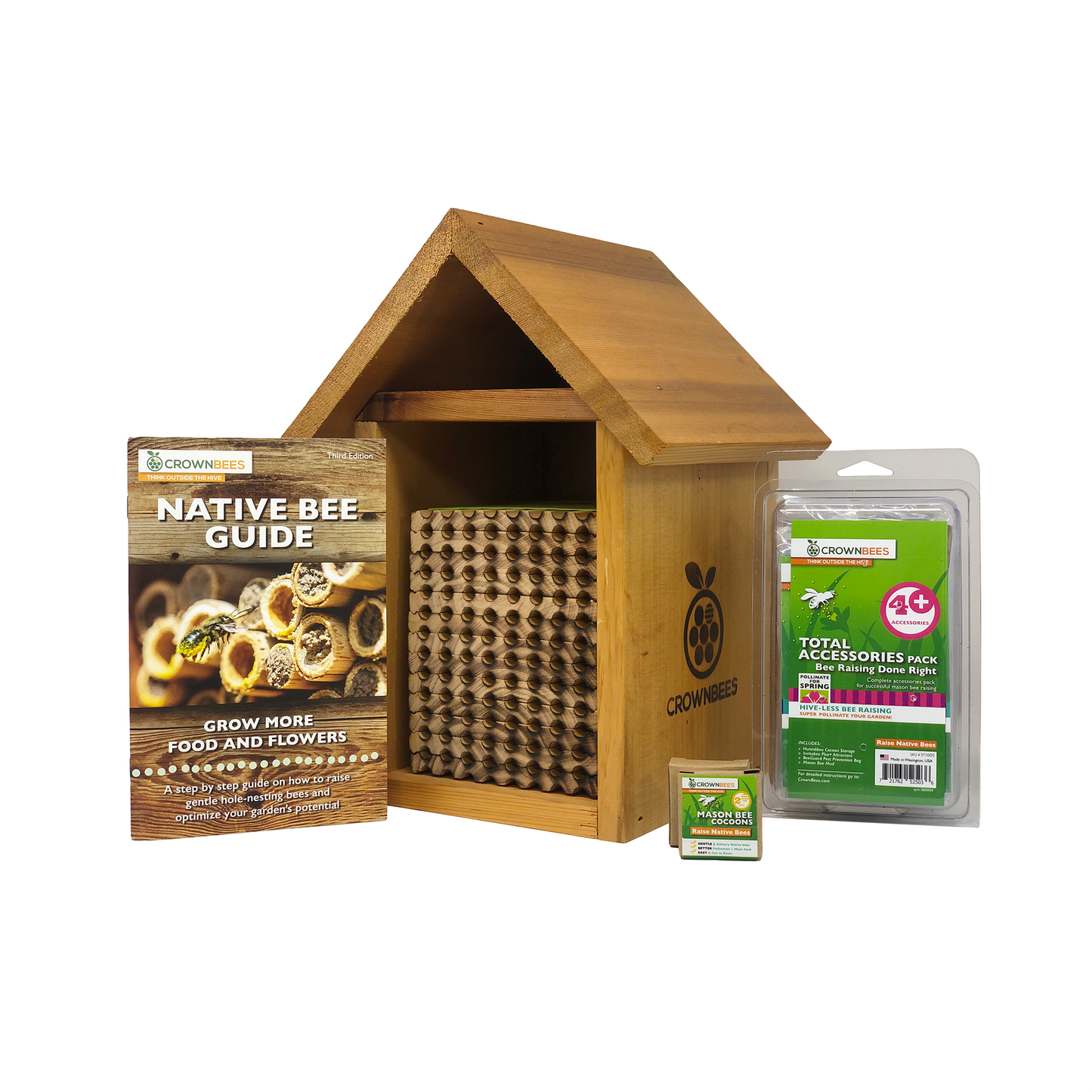
There's a reason we call them mason bees! Mason bees belong to the bee family Megachilidae, known as the architects of the bee world. Female mason bees build the walls of their nesting chambers out of mud or other "masonry" products to give each developing bee its own room in the nesting chamber. Female mason bees will then secure the nesting chamber with a thick mud end-cap to protect their offspring from predators until they emerge to pollinate the following spring.
Leafcutter bees also belong to this family, but they use leaves instead of mud as their primary nest construction material.
Because mud is vital for mason bee reproduction, females will not nest if they do not have a reliable source nearby (within 10 to 20 feet). However, not just any mud will do! Mason bees prefer to use mud with a high clay content - or that is the consistency of modeling clay. Mud that is damp with a high clay content allows the female to mold the mud to fit her nest perfectly; as the mud dries, it creates a strong protective barrier from predators.
Mud with a high sand content is more likely to break apart when it dries, which opens the door to predators.
Important: Ensure that the mud source is free of contamination, especially pesticides and road runoff, which could contain salt, oil residues, and other harmful and potentially lethal chemicals.

Three Ways to Provide Mason Bees with Clay-Rich Mud:
1. Naturally occurring clay-rich mud in your yard or garden
If your yard or garden has clay-rich mud, you can open an area of the ground with a trowel or shovel to give your bees easy access to the soil beneath the vegetation. Between 10 - 20 feet of your bee house, dig a hole with vertical walls. The vertical structure prevents the exposed soil from drying out quickly and gives the bees options of moisture levels. When collecting their building material, mason bees will work around the larger sand grains, small rocks, and other particles they don't want to find the perfect clump of clay-rich mud to bring back to their nest. The harder it is to excavate the clay from the soil, the more likely the bee will fly off in search of easier-to-access building materials. Just remember to check on your exposed mud source often to make sure it hasn't flooded or dried out!
So, how do you know if your yard or garden has clay-rich mud?
You can quickly check the soil texture - the percentage of sand, silt, and clay - of your yard or garden using the ribboning technique.
Ribboning Technique
1. Dig a small hole in the ground near your bee house and take a small handful of soil.
2. Add a bit of water and rub a bit of soil between your fingers to feel if it is gritty (sand), silky (silt), or sticky (clay).
3. Add enough water to make a ball. If you can't make a ball, or the ball falls apart easily, the soil is sandy and won't be good building material for the mason bees.
4. If you can make a ball, gently press it out over your forefinger to make a hanging ribbon.
5. If you can make a short ribbon (less than 1 inch), your soil texture is loamy, a mixture of sand, silt, and clay.
6. The longer the ribbon, the more clay is in your soil.
Check out this video from the University of Nebraska to see the ribboning technique in action!

2. Add Mason Bee Mud Mix
If your ribbon test demonstrates that you have sandy soil, you can add our Mason Bee Mud Mix to your yard or garden. Open the mud mix bag and slowly add water, kneading the mixture until it has the consistency of modeling clay. Add the kneaded mixture to one of the vertical walls in the hole you dug. Just remember to check on your exposed mud source often to make sure it hasn't flooded or dried out!
Pro Tip: Do not put Mud Mix or natural soil into a bowl. The mud will either dry out too quickly or flood in the rain. A vertical hole in the ground connects the mud to ground moisture and allows excess water to drain.
3. Set Up A Mason Bee Mud Box
For arid regions, rooftop gardens without ground to expose, or even if you struggle to keep your clay-rich mud damp throughout the day, our Mason Bee Mud Box is a great option.
Water is stored in the bottom of the mud box and is wicked up a capillary cloth to the Mason Bee Mud Mix (included). Follow the instructions for setting up the mud box, locating the mud between 10 - 25 feet of the bee house, and place in a shaded area to prevent the mud from drying out too quickly. You can keep the lid open or closed. The four access holes in the sides allow bees to enter and exit safely as they gather mud. Bees are easy prey when they are collecting mud, so we recommend leaving the lid closed if you have many birds in the area.
Pro Tip: Do not place mud directly under your mason bee house. Carrying mud straight up can be challenging for the small bees.
Besides mason bees, many beneficial wasps also come to gather mud! Solitary wasps that use mud tend to sonicate or vibrate the mud, resulting in a smooth, cement-like capped end. Mud-capped ends that appear bumpy or rough may have been filled by a mason bee. Learn more about the identification of cavity-nesting bees and wasps by reading our Capped-End Guide for Cavity-Nesting Bees.



